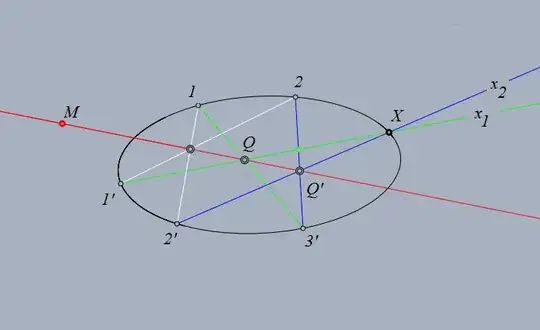I don't know if the following method is simpler but it gives a construction to find all the points of the ellipse. This method is based on Pascal's theorem and it cannot be understood without understanding at least the statement of the said theorem.
Let's see the following figure and follow the instructions.

If you have five points then, according to Pascal's theorem, you can choose any two of them and denote them by $1$ an $2$, and denote the remaining $3$ points by $1'$,$2'$, and $3'$.
Here is the construction which will find for you all the points on the ellipse.
- Join $1'$ and $2$ and $1$ and $2'$ with straight lines. (White segments; only for the sake of simplicity, I drew segments.)
- Choose an arbitrary point $M$ (distinct from the already given ones). This point will be called the moving point.
- Construct the straight line joining the moving point and the intersection of of $1'2$ and $2'1.$ (red line)
- Join $1$ with $3'$.
- Find the intersection point, $Q$, of $13'$ and the red line.
- Connect $1'$ with $Q$. (The green ray coming from $1'$: $x_1$)
- Join $2$ and $3'$. (blue line)
- Find the intersection point of the red line and $23'$. ($Q'$)
- Join $2'$ and $Q'$. (the blue ray denoted by $x_2$)
- Find the intersection point of $x_1$ and $x_2$: $X$.
Now, $X$ is a sixth point on the ellipse. If you move the moving point $M$ around then your points on the ellipse will loom up. After one revolution you can go through the points of the ellipse again and you can watch the intersection points of the red line and the ellipse. If this distance is maximal then the red line is on the great axis...
Good luck.
